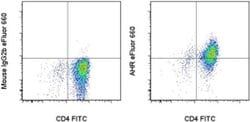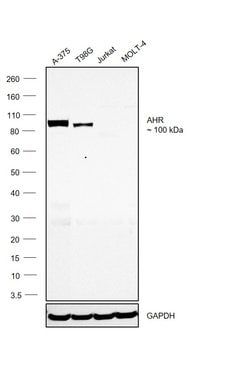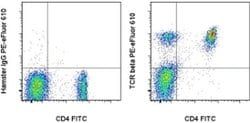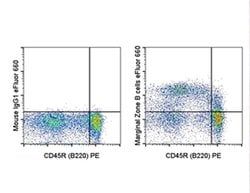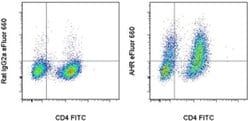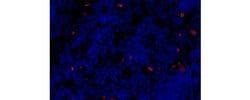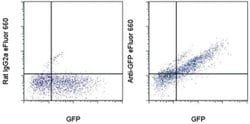50-112-4409
AHR Monoclonal Antibody (4MEJJ), eFluor™ 660, eBioscience™, Invitrogen™
Manufacturer: Invitrogen
Select a Size
| Pack Size | SKU | Availability | Price |
|---|---|---|---|
| Each of 1 | 50-112-4409-Each-of-1 | In Stock | ₹ 19,046.00 |
50-112-4409 - Each of 1
In Stock
Quantity
1
Base Price: ₹ 19,046.00
GST (18%): ₹ 3,428.28
Total Price: ₹ 22,474.28
Antigen
AHR
Classification
Monoclonal
Concentration
0.2 mg/mL
Formulation
PBS with 0.09% sodium azide; pH 7.2
Gene Accession No.
P30561
Gene Symbols
AHR
Immunogen
E. coli derived, His-tagged AHR (aa 443-805)
Quantity
25 μg
Primary or Secondary
Primary
Target Species
Mouse
Product Type
Antibody
Isotype
IgG2a κ
Applications
Flow Cytometry
Clone
4MEJJ
Conjugate
eFluor 660
Gene
AHR
Gene Alias
Ah; Ah receptor; Ahh; Ahr; Ahre; AH-receptor; aromatic hydrocarbon receptor; aryl hydrocarbon receptor; aryl-hydrocarbon receptor; bHLHe76; Class E basic helix-loop-helix protein 76; dioxin receptor; In
Host Species
Rat
Purification Method
Affinity chromatography
Regulatory Status
RUO
Gene ID (Entrez)
11622
Content And Storage
4° C, store in dark, DO NOT FREEZE!
Form
Liquid
Description
- Description: This 4MEJJ monoclonal antibody recognizes mouse aryl hydrocarbon receptor (AHR)
- The AHR is a ligand-activated transcription factor that mediates the toxic effects of a diverse group of environmental contamits, most notably aryl hydrocarbons such as polychlorinated biphenyls (PCB) and tetrachlorodibenzo-p-dioxin (TCDD)
- The AHR has also been shown to bind to a number of naturally occurring compounds found in fruits and vegetables as well as compounds generated through normal cellular metabolism
- AHR is localized in the cytoplasm in a complex that includes HSP90, p23, and XAP2/AIP/ARA9
- Upon ligand-binding, AHR translocates to the nucleus and binds with aryl hydrocarbon receptor nuclear translocator (ARNT), and this complex binds to the consensus DNA sequence, GCGTG, found in the promoter/enhancer regions of many genes such as CYP1A1
- The AHR is expressed in many cell types, with highest expression levels found in liver
- The AHR has been shown to play a role in the regulation/differentiation of Treg and Th17 cells
- The 4MEJJ monoclonal antibody has been found to recognize the b-1, b-2 and d alleles of mouse AHR but does not crossreact with human AHR
- Applications Reported: This 4MEJJ antibody has been reported for use in intracellular staining followed by flow cytometric analysis
- AHR (Ah Receptor) belongs to a family of proteins comprised of its dimerization partner ARNT (HIF-1 Beta) and the Drosophila proteins PER and SIM
- AHR contains an N-terminal sequence of approximately 200 amino acids termed the PAS domain
- AHR, found in a variety of tissues, binds to a specific DNA enhancer sequence and initiates transcription of the mRNA for the cytochrome P-450 (CYPIA1) gene
- The gene for AHR encodes a ligand-activated transcription factor involved in the regulation of biological responses to planar aromatic hydrocarbons
- AHR has been shown to regulate xenobiotic-metabolizing enzymes such as cytochrome P450, and its ligands included a variety of aromatic hydrocarbons
- AHR is a ligand-activated helix/loop/helix transcription factor found in a variety of vertebrate species
- The known ligands for AHR are foreign planar aromatic compounds, such as polycyclic aromatic compounds and halogenated aromatic compounds such as 2,3,7,8-tetrachlorodibenzo-p-dioxin (TCDD)
- Unlike the steroid/thyroid hormone receptors, there is no known physiological ligand for AHR
- Studies indicate that in non-ligand activated cells, AHR is found complexed with HSP90 predominantly in the cytoplasm
- Upon binding to an agonist, the ligand-activated AhR is believed to transform to a nuclear, DNA binding form, and this transformation process appears to involve dissociation of HSP90 from AhR followed by formation of a heterodimer with AhR nuclear translocator protein (Arnt)
- Diseases associated with AHR include eosinophilic fasciitis and seborrheic dermatitis.
Compare Similar Items
Show Difference
Antigen: AHR
Classification: Monoclonal
Concentration: 0.2 mg/mL
Formulation: PBS with 0.09% sodium azide; pH 7.2
Gene Accession No.: P30561
Gene Symbols: AHR
Immunogen: E. coli derived, His-tagged AHR (aa 443-805)
Quantity: 25 μg
Primary or Secondary: Primary
Target Species: Mouse
Product Type: Antibody
Isotype: IgG2a κ
Applications: Flow Cytometry
Clone: 4MEJJ
Conjugate: eFluor 660
Gene: AHR
Gene Alias: Ah; Ah receptor; Ahh; Ahr; Ahre; AH-receptor; aromatic hydrocarbon receptor; aryl hydrocarbon receptor; aryl-hydrocarbon receptor; bHLHe76; Class E basic helix-loop-helix protein 76; dioxin receptor; In
Host Species: Rat
Purification Method: Affinity chromatography
Regulatory Status: RUO
Gene ID (Entrez): 11622
Content And Storage: 4° C, store in dark, DO NOT FREEZE!
Form: Liquid
Antigen:
AHR
Classification:
Monoclonal
Concentration:
0.2 mg/mL
Formulation:
PBS with 0.09% sodium azide; pH 7.2
Gene Accession No.:
P30561
Gene Symbols:
AHR
Immunogen:
E. coli derived, His-tagged AHR (aa 443-805)
Quantity:
25 μg
Primary or Secondary:
Primary
Target Species:
Mouse
Product Type:
Antibody
Isotype:
IgG2a κ
Applications:
Flow Cytometry
Clone:
4MEJJ
Conjugate:
eFluor 660
Gene:
AHR
Gene Alias:
Ah; Ah receptor; Ahh; Ahr; Ahre; AH-receptor; aromatic hydrocarbon receptor; aryl hydrocarbon receptor; aryl-hydrocarbon receptor; bHLHe76; Class E basic helix-loop-helix protein 76; dioxin receptor; In
Host Species:
Rat
Purification Method:
Affinity chromatography
Regulatory Status:
RUO
Gene ID (Entrez):
11622
Content And Storage:
4° C, store in dark, DO NOT FREEZE!
Form:
Liquid
Antigen: AIRE
Classification: Monoclonal
Concentration: 0.2 mg/mL
Formulation: PBS with 0.09% sodium azide; pH 7.2
Gene Accession No.: Q9Z0E3
Gene Symbols: Aire
Immunogen: __
Quantity: 25 μg
Primary or Secondary: Primary
Target Species: Mouse
Product Type: Antibody
Isotype: IgG2c κ
Applications: Flow Cytometry, Immunocytochemistry, Immunohistochemistry (Frozen)
Clone: 5H12
Conjugate: eFluor 660
Gene: Aire
Gene Alias: Aire; AIRE protein; AIRE1; APECED; APECED protein; APECED protein homolog; APS1; APSI; Autoimmune polyendocrinopathy candidiasis ectodermal dystrophy protein; autoimmune polyendocrinopathy candidiasis ectodermal dystrophy protein homolog; Autoimmune regulator; autoimmune regulator (autoimmune polyendocrinopathy candidiasis ectodermal dystrophy); autoimmune regulator AIRE1a; LOW QUALITY PROTEIN: autoimmune regulator; OTTHUMP00000109529; PGA1
Host Species: Rat
Purification Method: Affinity chromatography
Regulatory Status: RUO
Gene ID (Entrez): 11634
Content And Storage: 4° C, store in dark, DO NOT FREEZE!
Form: Liquid
Antigen:
AIRE
Classification:
Monoclonal
Concentration:
0.2 mg/mL
Formulation:
PBS with 0.09% sodium azide; pH 7.2
Gene Accession No.:
Q9Z0E3
Gene Symbols:
Aire
Immunogen:
__
Quantity:
25 μg
Primary or Secondary:
Primary
Target Species:
Mouse
Product Type:
Antibody
Isotype:
IgG2c κ
Applications:
Flow Cytometry, Immunocytochemistry, Immunohistochemistry (Frozen)
Clone:
5H12
Conjugate:
eFluor 660
Gene:
Aire
Gene Alias:
Aire; AIRE protein; AIRE1; APECED; APECED protein; APECED protein homolog; APS1; APSI; Autoimmune polyendocrinopathy candidiasis ectodermal dystrophy protein; autoimmune polyendocrinopathy candidiasis ectodermal dystrophy protein homolog; Autoimmune regulator; autoimmune regulator (autoimmune polyendocrinopathy candidiasis ectodermal dystrophy); autoimmune regulator AIRE1a; LOW QUALITY PROTEIN: autoimmune regulator; OTTHUMP00000109529; PGA1
Host Species:
Rat
Purification Method:
Affinity chromatography
Regulatory Status:
RUO
Gene ID (Entrez):
11634
Content And Storage:
4° C, store in dark, DO NOT FREEZE!
Form:
Liquid
Antigen: AIRE
Classification: Monoclonal
Concentration: 0.2 mg/mL
Formulation: PBS with 0.09% sodium azide; pH 7.2
Gene Accession No.: Q9Z0E3
Gene Symbols: Aire
Immunogen: __
Quantity: 100 μg
Primary or Secondary: Primary
Target Species: Mouse
Product Type: Antibody
Isotype: IgG2c κ
Applications: Flow Cytometry, Immunocytochemistry, Immunohistochemistry (Frozen)
Clone: 5H12
Conjugate: eFluor 660
Gene: Aire
Gene Alias: Aire; AIRE protein; AIRE1; APECED; APECED protein; APECED protein homolog; APS1; APSI; Autoimmune polyendocrinopathy candidiasis ectodermal dystrophy protein; autoimmune polyendocrinopathy candidiasis ectodermal dystrophy protein homolog; Autoimmune regulator; autoimmune regulator (autoimmune polyendocrinopathy candidiasis ectodermal dystrophy); autoimmune regulator AIRE1a; LOW QUALITY PROTEIN: autoimmune regulator; OTTHUMP00000109529; PGA1
Host Species: Rat
Purification Method: Affinity chromatography
Regulatory Status: RUO
Gene ID (Entrez): 11634
Content And Storage: 4° C, store in dark, DO NOT FREEZE!
Form: Liquid
Antigen:
AIRE
Classification:
Monoclonal
Concentration:
0.2 mg/mL
Formulation:
PBS with 0.09% sodium azide; pH 7.2
Gene Accession No.:
Q9Z0E3
Gene Symbols:
Aire
Immunogen:
__
Quantity:
100 μg
Primary or Secondary:
Primary
Target Species:
Mouse
Product Type:
Antibody
Isotype:
IgG2c κ
Applications:
Flow Cytometry, Immunocytochemistry, Immunohistochemistry (Frozen)
Clone:
5H12
Conjugate:
eFluor 660
Gene:
Aire
Gene Alias:
Aire; AIRE protein; AIRE1; APECED; APECED protein; APECED protein homolog; APS1; APSI; Autoimmune polyendocrinopathy candidiasis ectodermal dystrophy protein; autoimmune polyendocrinopathy candidiasis ectodermal dystrophy protein homolog; Autoimmune regulator; autoimmune regulator (autoimmune polyendocrinopathy candidiasis ectodermal dystrophy); autoimmune regulator AIRE1a; LOW QUALITY PROTEIN: autoimmune regulator; OTTHUMP00000109529; PGA1
Host Species:
Rat
Purification Method:
Affinity chromatography
Regulatory Status:
RUO
Gene ID (Entrez):
11634
Content And Storage:
4° C, store in dark, DO NOT FREEZE!
Form:
Liquid
Antigen: GFP
Classification: Monoclonal
Concentration: 0.2 mg/mL
Formulation: PBS with 0.09% sodium azide; pH 7.2
Gene Accession No.: __
Gene Symbols: __
Immunogen: __
Quantity: 100 μg
Primary or Secondary: Primary
Target Species: Tag
Product Type: Antibody
Isotype: IgG2a κ
Applications: Flow Cytometry
Clone: 5F12.4
Conjugate: eFluor 660
Gene: __
Gene Alias: GFP; GFP tag; GFP2; green fluorescence; green fluorescent; Turbo eGFP
Host Species: Rat
Purification Method: Affinity chromatography
Regulatory Status: RUO
Gene ID (Entrez): __
Content And Storage: 4° C, store in dark, DO NOT FREEZE!
Form: Liquid
Antigen:
GFP
Classification:
Monoclonal
Concentration:
0.2 mg/mL
Formulation:
PBS with 0.09% sodium azide; pH 7.2
Gene Accession No.:
__
Gene Symbols:
__
Immunogen:
__
Quantity:
100 μg
Primary or Secondary:
Primary
Target Species:
Tag
Product Type:
Antibody
Isotype:
IgG2a κ
Applications:
Flow Cytometry
Clone:
5F12.4
Conjugate:
eFluor 660
Gene:
__
Gene Alias:
GFP; GFP tag; GFP2; green fluorescence; green fluorescent; Turbo eGFP
Host Species:
Rat
Purification Method:
Affinity chromatography
Regulatory Status:
RUO
Gene ID (Entrez):
__
Content And Storage:
4° C, store in dark, DO NOT FREEZE!
Form:
Liquid

